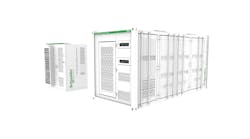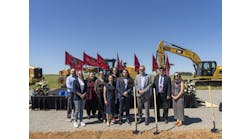Flow batteries, with their long-duration storage capabilities, reportedly can reduce costs and provide resilience in ways that can cut microgrid costs, reduce the need for sourcing metals outside the U.S. and speed the clean energy transition.
For example, flow battery provider ESS has completed a microgrid installation at Sycamore International, a technology recycling company in West Grove, Pennsylvania. ESS said its long-duration iron flow batteries are less expensive than other storage alternatives, in part because of their long life cycle. According to ESS, the iron flow battery in its Energy Warehouse will last for more than 20,000 cycles — or more than 20 years — without any capacity degradation.
San Diego Gas & Electric is installing a flow battery in its Cameron Corners microgrid, with a goal of reducing wildfire risks and the impact of public safety power shutoffs during extreme weather conditions. The microgrid will consist of solar and battery storage that will provide resilience to a middle school, library, health clinic, fire station and telecommunications hub.
National labs study CMBlu’s redox flow battery
Now, two national labs – Argonne National Laboratory and Idaho National Laboratory (INL) – are testing how a 10-hour redox flow battery from CMBlu Energy, based in Germany, compares to lithium-ion batteries in a microgrid. The project aims to lower demand charges and provide resilience for an electric vehicle (EV) charging application, said Giovanni Damato, president of CMBlu’s U.S. operations.
After evaluating the battery technology – CMBlu’s Organic SolidFlow Battery – Argonne and INL intend to demonstrate the battery’s capabilities to stakeholders and decision makers, said a spokesperson for Argonne.
“By doing so, the project teams hope to spur the momentum necessary for the technology liftoff, facilitating widespread adoption of an energy storage solution that is not only efficient but also sustainable and low risk,” the spokesperson said.
Helping make fast charging affordable
The project could boost the resilience of microgrids by demonstrating constant power supply, even during outages, said CMBlu. It also aims to make fast charging of EVs more affordable in rural and underserved communities by lowering the installation and operational costs of charging stations.
“They’re demonstrating how a 10-hour duration battery has certain benefits, especially paired with EV charging,” said Damato. The demonstration will test whether the batteries ensure EV charging could continue when the grid is down.
The batteries are unique because their components are carbon-based rather than metal-based, which are more expensive and harder to find. CMBlu’s battery components can be sourced in the U.S. and are recyclable, said Damato.
“There’s a huge supply chain locally in the U.S. and other countries,” he said.
CMBlu’s batteries said to be cost-competitive with lithium ion
In addition, the alternative batteries are cost-competitive with lithium ion after five hours, he claimed.
“For price, our system’s sweet spot in duration is the four- to 12-hour range. A standard unit is five hours. At that point, it’s competitive with lithium-ion batteries,” he said.
In addition to reducing demand charges for EV charging, applications for the batteries range from disaster relief to storing electricity from a cogeneration plant.
The systems are more modular than lithium-ion batteries, with the unit about the size of a standing desk. They can be moved from place to place for disaster response applications.
Car maker wants flow battery for renewable energy
CMBlu Energy recently announced that Mercedes-Benz Group ordered an 11- MWh CMBlu Energy SolidFlow Battery for the microgrid at its Rastatt plant in Germany. Mercedes-Benz is trying to increase the amount of renewable energy used to supply its production efforts and will use the battery to boost its clean energy and resiliency.
In addition, CMBlu is doing a demonstration project for WEC Energy Group in Wisconsin. The battery is located inside a power plant and will help address winter peaks, said Damato. The utility has the largest district heating loop in the U.S., and the loop heats downtown Milwaukee with steam from a cogeneration plant. The electricity component from the plant sometimes goes to waste because the demand for heat and electricity aren’t aligned in the winter.
“We’re working on storing that electricity and using it other times when electricity demand is high,” said Damato.
Battery deployments to help meet climate goals
The advantages of flow batteries are becoming more important as efforts grow to deploy more energy storage. A recent report from the International Energy Agency (IEA) found that fast expansion of batteries is critical to meeting climate and energy security goals established at COP 27.
“Batteries will be critical to achieving the energy goals agreed by nearly 200 countries at the COP28 climate change conference in Dubai, notably tripling renewable energy capacity by 2030, doubling the pace of energy efficiency improvements and transitioning away from fossil fuels,” said the IEA in the report.
CMBlu and the national laboratories hope to contribute to meeting those goals by identifying some of the best use cases for CMBlu’s lower cost, long-duration storage.
Related Long-Duration Battery Stories in MGK
HydroStor Reaches Key Milestone in 500-MW Project in California
Smartville Receives $10M for DOE for LDES Project








